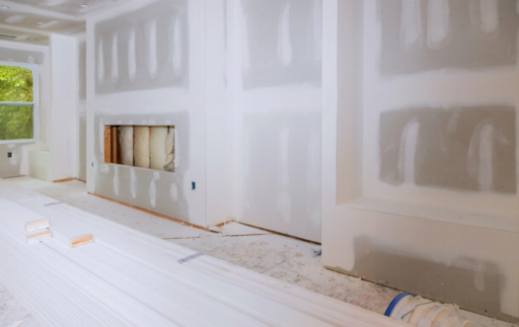The Ultimate Guide to Soundproofing Your Home with Drywall
22 March 2025 by Kyron D.Are you tired of hearing the noises from outside or from room to room within your home? Soundproofing with drywall is a popular and effective solution to create a peaceful environment. Understanding sound transmission and choosing the right materials are essential steps in achieving maximum sound reduction. With the proper installation techniques and additional soundproofing strategies, you can enjoy a quieter and more tranquil living space.

Understanding Sound Transmission and Drywall Basics
In the context of home renovations, sound transmission can be a major concern for homeowners looking to reduce noise from neighbors, traffic, or other sources. Drywall, also known as gypsum board or wallboard, is a commonly used building material that plays a key role in soundproofing. It consists of gypsum plaster sandwiched between two layers of paper, providing a durable and seamless surface for walls and ceilings. The effectiveness of drywall in soundproofing depends on its thickness and density. Thicker and denser drywall will generally provide better soundproofing capabilities than thinner and less dense options. Additionally, incorporating multiple layers of drywall with an air gap between them can further improve sound insulation. In terms of sound transmission, airborne sound and impact sound are the two main types of noise that can pass through walls. Airborne sound, such as voices or music, travels through the air and can easily pass through walls if they are not adequately insulated. Impact sound, such as footsteps or objects dropping, travels through vibrations in the structure of the building and can be more difficult to control. To effectively soundproof a room with drywall, it is important to address both airborne and impact sound transmission. This can be achieved through proper installation techniques, such as using resilient channels or soundproofing compounds to minimize noise transfer. By understanding the principles of sound transmission and the basics of how drywall can be used to improve soundproofing, homeowners can make informed decisions when undertaking renovations to create a more peaceful and quiet living space.Selecting the Right Materials for Soundproofing
When it comes to soundproofing your home with drywall, selecting the right materials is crucial for achieving optimal results. One of the key materials to consider is resilient channels, which are metal strips that are installed between the wall studs and the drywall. These channels help to decouple the drywall from the studs, reducing sound transmission through the walls. Another important material to consider is soundproofing compound, which is applied between the layers of drywall to help absorb sound vibrations. This compound can significantly enhance the soundproofing capabilities of the drywall, making it an essential component in any soundproofing project. In addition to resilient channels and soundproofing compound, it is also important to choose the right type of drywall for soundproofing purposes. Traditional drywall is effective at blocking high-frequency sounds, but for low-frequency sounds, it is recommended to use a thicker and denser type of drywall, such as double-layered or specially designed soundproof drywall. By carefully selecting the right materials for soundproofing, you can effectively reduce the transmission of unwanted noise in your home and create a more peaceful and quiet living environment.Installation Tips for Maximum Sound Reduction with Drywall
To achieve maximum sound reduction with drywall, proper installation techniques are crucial. Here are some tips to help you effectively soundproof your home with drywall:Double up on drywall: One effective method for increasing sound reduction is to install two layers of drywall instead of the standard single layer. By doubling up the drywall, you create a thicker barrier for sound to penetrate, resulting in improved soundproofing.
Use soundproofing compound: Consider applying a soundproofing compound between the layers of drywall to further reduce sound transmission. This compound helps to dampen vibrations and absorb noise, enhancing the overall soundproofing effectiveness of the drywall.
Seal all seams and gaps: Proper sealing of seams and gaps is essential to prevent sound from leaking through. Use acoustical caulk or putty to seal any gaps between the drywall sheets, as well as around electrical outlets, door frames, and windows.
Install resilient channels: Resilient channels are metal strips that are attached to the studs before installing the drywall. These channels help to decouple the drywall from the structure, reducing sound transmission through the walls. Be sure to follow manufacturer guidelines for proper installation of resilient channels.
Minimize wall penetrations: Sound can easily travel through openings in the walls, such as outlets, switches, and light fixtures. To reduce sound transmission, use soundproofing electrical boxes and gaskets to seal these penetrations and prevent sound leakage.
Consider soundproofing insulation: Adding soundproofing insulation, such as fiberglass or mineral wool, within the wall cavities can further enhance soundproofing. The insulation helps to absorb sound waves and reduce noise transfer between rooms. By implementing these installation tips and techniques, you can significantly improve the soundproofing capabilities of your drywall and create a more peaceful and quiet living environment in your home.